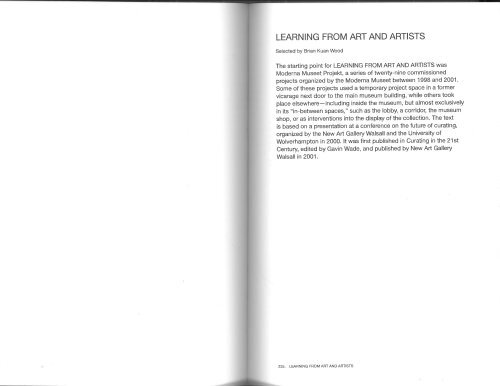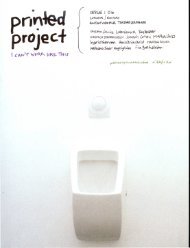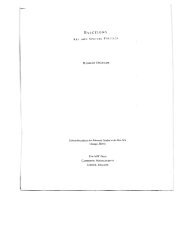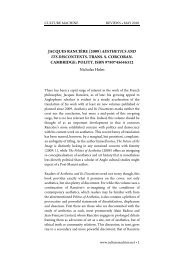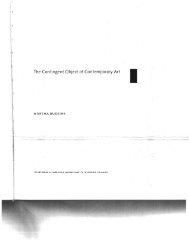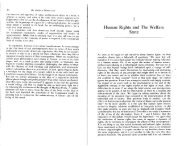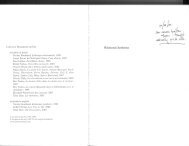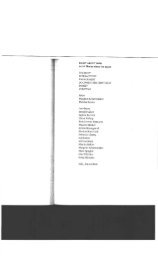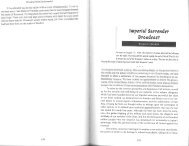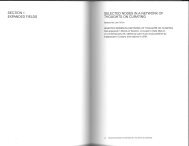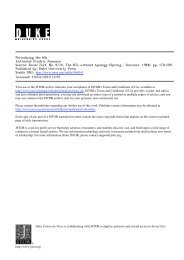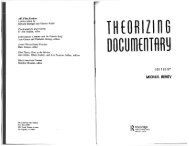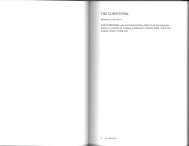Maria Lind, "Learning From Art and Artists" - doublesession
Maria Lind, "Learning From Art and Artists" - doublesession
Maria Lind, "Learning From Art and Artists" - doublesession
You also want an ePaper? Increase the reach of your titles
YUMPU automatically turns print PDFs into web optimized ePapers that Google loves.
LEARNING FROM ART AND ARTISTS<br />
Selected by Brian Kuan Wood<br />
The starting point for LEARNING FROM ART AND ARTISTS was<br />
Moderna Museet Projekt, a series of twenty-nine commissioned<br />
projects organized by the Moderna Museet between 1998 <strong>and</strong> 2001.<br />
Some of these projects used a temporary project space in a former<br />
vicarage next door to the main museum building, while others took<br />
place elsewhere-including inside the museum, but almost exclusively<br />
in its "in-between spaces," such as the lobby, a corridor, the museum<br />
shop, or as interventions into the display of the collection. The text<br />
is based on a presentation at a conference on the future of curating,<br />
organized by the New Ar1 Gallery Walsall <strong>and</strong> the University of<br />
Wolverhampton in 2000. lt was first published in Curating in the 21st<br />
Century edited by Gavin Wade, <strong>and</strong> published by New <strong>Art</strong> Gallery<br />
Walsall in 2001.<br />
235. LFARNING FROM ARTAND ARTISTS
Located next to the l/oderna<br />
Museet's main bui¡ding in<br />
Stockholm, The Mcarage<br />
served as the temporary projæt<br />
space of ¡/oderna Museet<br />
ProjeK from 1 998 to 2000<br />
ANNIKA ERIKSSON,<br />
COLLECTORS,1998<br />
Exhibition view at<br />
Moderna Museet Projekt.<br />
ANNIKA ERIKSSON,<br />
COLLECTORS,1998<br />
Video installation, five<br />
single-channel video<br />
loops, each 20 min.<br />
Kr¡st¡na Björk collects pictures of<br />
Esther Will¡ams.<br />
ANNIKA ERIKSSON,<br />
COLLECTORS, l99B<br />
Video installation, five<br />
single-channel video<br />
loops, each 20 min.<br />
Andreas Hammar collæts vidæ<br />
games <strong>and</strong> old computeß<br />
236 SELECTED MARIA LIND WRITING 237. LEARNING FROM ARTAND ARTISTS<br />
l,'t Tr. l.rfitcr but .r[w (ìtd ((ìnìputcr..
ANN¡KA ERIKSSON,<br />
COLLECTORS,1998<br />
Video installation, five<br />
single-channel video<br />
loops, each 20 min.<br />
Bengt Forslund collects devils<br />
ANNIKA ERIKSSON,<br />
COLLECTORS, l99B<br />
Collectors meet<br />
with members of<br />
the Samlarförbundet<br />
Nordstjärnan (Nor1h star<br />
collectors' association)<br />
outside the Moderna<br />
Museet's main entrance.<br />
HINRICH SACHS, ANNA<br />
GILI, DESIGNER, VISITS<br />
HINRICH SACHS, 1998<br />
Poster as part of<br />
Hinrich Sachs's Anna<br />
Gili, designeç vìsits<br />
Hinrich Sachs.<br />
HINRICH SACHS, ANNA<br />
GILI, DESIGNER, VISITS<br />
HINRICH SACHS, 1998<br />
Live portraÌt at the<br />
business travelers' lounge<br />
of Stockholm's Central<br />
Train Station, seen here in<br />
the background from the<br />
main hall area.<br />
238 SELECTED N1ARIA LIND WRITING 23S. LEARNING FROI\,4 ART AND AFTISTS
240 SELECTED MARIA LIND WRITING<br />
HINRICH SACHS, ANNA<br />
GILI, DESIGNER, VISITS<br />
HINRICH SACHS, 1998<br />
Live portrait at the<br />
business travelers, lounge<br />
of Stockholm's Central<br />
Train Station, seen here<br />
from inside the lounge.<br />
HINRICH SACHS, ANNA<br />
GILI, DESIGNER, VISITS<br />
HINRICH SACHS, 1998<br />
Anna Gili's armchair<br />
Tonda, designed for a<br />
television program in ltaly,<br />
<strong>and</strong> examples of her<br />
glass design.<br />
HINRICH SACHS, ANNA<br />
GILI, DESIGNER, VISITS<br />
HINRICH SACHS, 1998<br />
Vitrine containing<br />
samples of Anna Gili's<br />
glass designs <strong>and</strong> the<br />
ingredients of her favorite<br />
drink, limoncello.<br />
HINRICH SACHS, ANNA<br />
GILI, DESIGNER, VISITS<br />
HINRICH SACHS, 1998<br />
Lamp designed by Anna<br />
Gili <strong>and</strong> a recorded<br />
interview with Gili by<br />
Hinrich Sachs.<br />
241 LEARNING FROM ART AND ARTISTS
LEARNING FROM ART AND ARTISTS<br />
ln summer of 1999, travelers using the business lounge of<br />
Stockholm's central train station found themselves in a portrait of<br />
the well-known ltalian designer, Anna Gili. The poftrait took the form<br />
of a rather discrete installation containing not a single image of its<br />
subject, but instead comprising her work the Tonda armchair, a lamp,<br />
<strong>and</strong> several vases, some personal belongings such as a book <strong>and</strong><br />
a pair of sunglasses <strong>and</strong> the ingredients of limoncello, her favorite<br />
drink. Hinrich Sachs's work in Citysalongen Anna Gili, designer, visits<br />
Hinrich Sachs, provides an interesting example of how contemporary<br />
art wants to, <strong>and</strong> can, infiltrate reality. lt exemplifies a desire to escape<br />
the institutional framework <strong>and</strong> the traditional relationship between<br />
art <strong>and</strong> its audience-in this case becoming something to stumble<br />
over rather than consume in a neatly packaged form. The location of<br />
the central station was carefully chosen, considering the impoftance<br />
of mobility <strong>and</strong> communication nowadays, as well as the designer's<br />
particular approach to this phenomenon. Visitors could listen to a<br />
recording of the artist interviewing Anna Gili, who discusses her views<br />
on design, our relationship to material things in today's nomadic<br />
environment, <strong>and</strong> what it is like to be a woman in the male-dominated<br />
design world, among other subjects.<br />
How can one combine skepticism with enthusiasm? Affirmation<br />
with criticism? Openness with precision? A focus on a part <strong>and</strong> on<br />
the whole? However vague, these are important questions both<br />
for contemporary art <strong>and</strong> for those of us who work with it. They<br />
influence my general practice as a curator at the Moderna Museet,<br />
<strong>and</strong> specifically inform two of the projects I would like to discuss<br />
here: Moderna Museet Projekt (of which Hinrich Sachs's work was a<br />
part) <strong>and</strong> "What lf: <strong>Art</strong> on the Verge of Architecture <strong>and</strong> Design." I will<br />
look at the role of institutions in relation to curating in the twenty-first<br />
century-i.e., here <strong>and</strong> now-<strong>and</strong> how I think we can learn from aft<br />
<strong>and</strong> artists.<br />
When one tries to couple contemporary art with art institutions such<br />
as museums, what takes shape appears to be a paradox, something<br />
that Gerlrude Stein pointed out when she said, "You can be a<br />
museum, or you can be modern, but you can't be both." The kind of<br />
contemporary art I have in mind is art in the exp<strong>and</strong>ed field, art that,<br />
like Hinrich Sachs's work, moves out of the white cube <strong>and</strong> outside<br />
243 LEARNING FROM ARTANDARTISTS
the institutions, that wants to interfere with <strong>and</strong> intervene in the<br />
surrounding reality through an orientation towards the everyday.<br />
When it is not downright critical of institutions, it wants to simply avoid<br />
the solemnity <strong>and</strong> stasis that often characterize them. This kind of art<br />
works on a small scale without too many overarching assumptionsit<br />
has to do with testing a model or prototype while focusing on<br />
concrete situations, processes <strong>and</strong> effects, services <strong>and</strong> actions. lt<br />
is rarely studio-based <strong>and</strong> often requires production by professionals<br />
other than the artist. These artists are exploring art as a testing ground<br />
for work whose implications go far beyond the realm of art, <strong>and</strong> they<br />
are doing it in a challenging way.<br />
These processes have been circulating in art production over the<br />
last forty years, <strong>and</strong> although some have made their mark on the<br />
institutions <strong>and</strong> their way of functioning, they are still not<br />
acknowledged to the degree that one would expect. How can we<br />
today show these often ephemeral projects in institutional exhibition<br />
spaces? First of all, I believe that we need to distinguish between<br />
the occasion at which process-based projects take place <strong>and</strong> their<br />
afterlife, their documentation. I am unsure that a more classical<br />
approach to documenting projects with photographs <strong>and</strong> text belongs<br />
in an exhibition, just as it has been problematic with conceptual<br />
art's afterlife. Perhaps these function better in a publication or on a<br />
Web site. But more impoftantly, I think that we have to get used to<br />
pronouncing the words "showing" <strong>and</strong> "exhibition" less frequently. An<br />
institution is still primarily thought of as a showroom, <strong>and</strong> exhibitions<br />
are still taken for granted as being the natural way of dealing with<br />
art. ln reality, an exhibition is just one way of working with art among<br />
many. Just as so many artists use the medium <strong>and</strong> technique relevant<br />
to the questions they ask, so do we also have to ask which format for<br />
presenting work is relevant to their works.<br />
ln conjunction with the inauguration of the Moderna Museet's new<br />
building (designed by Rafael Moneo) in February of 1998, we began<br />
a new initiative entitled Moderna Museet Projekt, or MMP.1 When<br />
I started working as a curator at the Moderna Museet towards the<br />
end of 1997, I had a basic question: How is it possible to work with<br />
1 Unt¡l June 2000, the artists who have participated in Moderna [/useet Prcjekt have been: l\¡ar¡a <strong>Lind</strong>berg,<br />
Koo Jeong-A, Peter Geschw¡nd (Centre Culturel Suédois à Paris), Annika Er¡kson, Eriks Bozis (Hötorget,<br />
Stockholm), Tobias Rehberger, Emese Benczúr (Skeppsholmen, Stockholm), Fanni N¡emi-Junkola, S¡mon<br />
Starl¡ng, Apolonia SuéterÉ¡¿, Miriam Bäckström, Matts Leideßtam (Centre Culturel Suálois à Paris), Ann<br />
Lislegaard, Jason Dodge, Douglas Gordon, Honoré d'O (¡n the lobby of the museum's ma¡n building), Tor-<br />
Magnus Lundeby, Magnus Wa¡l¡n, <strong>and</strong> Claire Barclay.<br />
244 SELECTED MAFIA LIND WRITING<br />
contemporary ar1 in this context? How can I be sensitive to the<br />
logic of this practice <strong>and</strong> still avoid letting the institution dominate?<br />
How does one combine this pafticular institutional framework with<br />
the surprise, questioning, contemplation, <strong>and</strong> problematization that<br />
define contemporary arT? Thanks to the suppott of David Elliott, the<br />
director of the museum at the time, I drew up an outline for MMP as<br />
a completely new activity for addressing several different ways of<br />
working with contemporary art, from having classic retrospectivessuch<br />
as that of Cecilia Edefalk-to curated group shows such<br />
as "After the Wall: <strong>Art</strong> <strong>and</strong> Culture in Post-Communist Europe,"<br />
"Organising Freedom: Nordic <strong>Art</strong>ists of the '90s" <strong>and</strong> "What lf: <strong>Art</strong> on<br />
the Verge of Architecture <strong>and</strong> Design."<br />
As such, MMP becomes a contribution to an ongoing discussion<br />
about the function <strong>and</strong> the role of the museum: ls its sole purpose<br />
really to display <strong>and</strong> mediate art? Or should the museum function as<br />
a production site <strong>and</strong> distribution channel as well? And if so, how can<br />
we make that happen? We have chosen to see the Moderna Museet<br />
as all of these things; we feel that we should not only reflect that<br />
which already exists, but also contribute to the creation of new art.<br />
We should, among other things, play the role of midwife to emerging<br />
art-allowing art <strong>and</strong> artists to inform the museum-which becomes<br />
increasingly important when one considers how much contemporary<br />
art is difficult or even impossible to sell.<br />
Since many aftists reach out to the surrounding reality beyond art<br />
institutions, we thought it suitable to not bind the projects to the<br />
museum's new building, but rather to shadow the artists, to follow<br />
them art out of the museum's walls. However, this also indicates<br />
how important it is to realize that, like other museums, the Moderna<br />
Museet is not synonymous with the museum building itself. lnstead,<br />
the Moderna Museet should be seen as the sum of its activities,<br />
whether indicated by the extension of the MMP to wherever the adist<br />
wishes to work, or the work of the Moderna Museet lnternational<br />
Programme, responsible for Sweden's pafticipation in international<br />
exhibitions such as the Venice <strong>and</strong> São Paulo biennials. Put another<br />
way, a museum is a complex communication structure.<br />
ln this way, the MMP became a satellite whose orbit sometimes<br />
brought it close to the museum, if not inside, <strong>and</strong> at other times sent<br />
it far away. Adists are invited to visit us before the MMP begins, often<br />
more than once, in order to acquaint themselves with the institution,<br />
245. LEARNING FROM ABTANDARTISTS
the city, <strong>and</strong> to a certain extent the cultural scene as well. So far, the<br />
artists have come in yearly groups, <strong>and</strong> since MMp can be likened<br />
to a group exhibition extended in time rather than in space, it is<br />
important that the participants get a sense of their context by meeting<br />
each other <strong>and</strong> learning about each other,s work. Following each<br />
MMP, the new works are documented visually with an accompanying<br />
text in a small catalogue produced in both English <strong>and</strong> Swedish.<br />
ln the summer of 1998, Annika Eriksson filled the assembly hall of<br />
Prästgården (the Vicarage)-a small, intimate building close to the<br />
museum's main entrance-with twenty collectors for the production<br />
of her video-based work collectors (samlare). Like all artists invited<br />
to work in the MMB the Moderna Museet offered Eriksson a fee, a<br />
production budget, <strong>and</strong> a great deal of practical assistance in bringing<br />
her work to fruition. Through the samlarförbundet Nordstjärnan (North<br />
star collectors' organization) <strong>and</strong> various friends <strong>and</strong> acquaintances,<br />
Eriksson met various people who collect everything from piggybanks,<br />
pocketknives, film posters, <strong>and</strong> action figures to Barbie dolls <strong>and</strong><br />
Kinder eggs. She asked if she could visit these people at home to<br />
document their stories of how they began collecting, how they go<br />
about collecting, what their collections mean to them, <strong>and</strong> so for1h.<br />
The subjects were asked to compose their own shots themselves,<br />
<strong>and</strong> after listening to them for a while, one finds this form of pure<br />
documentary to become not only poetic, but also remarkably<br />
existential. collectors became a powerful piece of work about how we<br />
choose to give order to our lives. ln collaboration with North sta¡ the<br />
artist also arranged three so-called "collector's meetings" outside the<br />
museum's main entrance, where collectors could come <strong>and</strong> display<br />
their collections <strong>and</strong> sell or swap items. This wonderfully reflected the<br />
Moderna Museet's approach to collecting, as well as the nature of<br />
the museum's collection itself, with the private-<strong>and</strong> sometimes even<br />
eccentric-alongside the very public. And Collectors became one<br />
of several works made for MMP that entered the Moderna Museet,s<br />
collection.<br />
At a time when much art is moving away from institutions or only<br />
maintains a loose connection to them, <strong>and</strong> when it seems difficult<br />
to find new models to apply when discussing contemporary art, the<br />
unavoidable question that arises is: Does this kind of contemporary<br />
ad even need the institutions at all? Can this art not communicate<br />
directly with the audience? Have the institutions become redundant?<br />
While the role of art institutions has been questioned constantly<br />
246. SELECTED MARIA LIND WRITING<br />
over the last forty years, the discussion still remains highly pertinent.<br />
Beyond Foucault's well-known research into the regulátive function<br />
of prisons, schools, hospitals, <strong>and</strong> museums, Habermas'opinion<br />
that they comprise the foundation for the development of democracy<br />
remains probably the most influential formulation.<br />
To further consider the pressing issue of how to work with<br />
contemporary art from within an institution, I would like to mention<br />
the ideas of Roberto Mangabeira unger, a social theorist <strong>and</strong> activist,<br />
as well as a professor of law at Harvard. Though his political attitude<br />
can sometimes be a bit awkward, he takes a refreshing approach<br />
to institutions. ln his book Democracy Realized: The Progressive<br />
Alternative, he discusses practical alternatives to neoliberalism <strong>and</strong><br />
social democracy, stressing the need for institutional change, a kind<br />
of institutional experimentalism in which imagination is central.2' ln<br />
times when dem<strong>and</strong>s for high numbers of visitors <strong>and</strong> emphasis on<br />
outreach programs <strong>and</strong> audience-friendly work threaten to eclipse art,<br />
these experimental approaches become all the more pressing'<br />
Beyond the obvious archival function of gathering our collective<br />
memories, I believe we still need art institutions to act as platforms<br />
for experimental art. However, the institutions must become more<br />
flexible <strong>and</strong> heterogeneous, just as art itself is, <strong>and</strong> those of us who<br />
work in institutions must be more imaginative. The institutions must<br />
be capable of renewing <strong>and</strong> reinventing both their own formats <strong>and</strong><br />
their audiences on a regular basis. Those of us who work within their<br />
frameworks must refine our strategies <strong>and</strong> our methods of address.<br />
The paradox that I mentioned earlier only becomes a deadlock when<br />
institutions conform exclusively to the routines of functioning as a<br />
showroom <strong>and</strong> an archive.<br />
Most of the methods <strong>and</strong> strategies I have mentioned are closely<br />
related to those of artists themselves. I think while working with<br />
art in general, <strong>and</strong> especially within institutions, we can benefit<br />
tremendously by looking at artists <strong>and</strong> learning from their ways of<br />
working. of course this is not a new idea: even in the '1 920s Alex<strong>and</strong>er<br />
Dorner, as director of the L<strong>and</strong>esmuseum in Hanover, turned to both<br />
Theo van Doesburg <strong>and</strong> El Lisstzky for the installation of Room for<br />
constructive <strong>Art</strong>. The latter then completed the Abstract cabinet in<br />
1927. As the director of the Moderna Museet in the 1960s, Pontus<br />
Hultén was unusually open to influences from pop art <strong>and</strong> artists'<br />
2. Robefto Mangabe¡ra unget Democracy Real¡zed: The Progressive Alternative (London: verso, 1 998)<br />
247. LEARNING FROM ARTANDABTISTS
É<br />
Even an estabrishment institution rike MoMA craims to have a serious<br />
engagement. in contempo rary arl. rts mission statement from 1 gg7<br />
says "that it is essentiar to affirm the impoftance of contemporary<br />
art <strong>and</strong> artists if the museum is to honor the ¡oears wiirr which it was<br />
founded <strong>and</strong> to remain vital<strong>and</strong> engaged with the present.,,And<br />
it continues by saying that ,,this commitment to contempo rary aft<br />
enrivens <strong>and</strong> informs our evorving underst<strong>and</strong>ing of the traditions of<br />
modern aft.',<br />
rt is arguabre whether or not MoMA's statement is mere rip service.<br />
need for openness <strong>and</strong> sensitivity<br />
certain kind of contemporary art,<br />
can provide interesting models<br />
dispray it, but arso ro, ,"oi"tl5i:"?,i: Hï1""1,,l"å,åoq:::ï"#,,u<br />
historicaily often emerged from the institutionat critique oiartists<br />
such as Daniel Buren, Hans Haacke, Fred Wilson, nſrea Fraser,<br />
<strong>and</strong> many others. Site_specific work, at least according to Miwon<br />
Kwon, also grew out of their work <strong>and</strong> attitudes, even when more<br />
site-oriented than site-specific. Just as these figures furthered the<br />
discussion in their time, so can we rearn a tremendous amount from<br />
our own contemporaries.<br />
shorry after the inauguration of the new Moderna Museet buirding,<br />
a ritte boy came to visit the museum with his mother. upon entering<br />
the buirding, he suddenry excraimed, "Mommy, this rooks rike Arr<strong>and</strong>a<br />
airport!" Not onry was he perfectry correct, but he essentiaty quoted<br />
one of the Swedish critics who commented on the new buirding as<br />
being somewhat monumentar, with an authoritarian feer to it. rt is<br />
arso a prace where security is top priority, not reast since the "Rifif¡"<br />
burgrary in November 1gg3 when some burgrars broke in through<br />
picassos <strong>and</strong> Braques, only to Oe tong<br />
arrived.3. lt is nowadays a heavily guaøeO<br />
ere the collection can be safely þrotected<br />
s something in<br />
invited to MMB<br />
e reers controred ""üldhqil:,,<br />
carrying anything itegar, you worry about the security.-tnis became<br />
3' The inc¡dent was nicknamed after the 1955 French film R¡fifi, ¡n which the same method was used<br />
248 SELECTED MARIA LIND WRITING<br />
the starting point for a new piece called Fold M to M, which enters<br />
into a dialogue with the building. He pasted white cotton on the<br />
glass walls <strong>and</strong> doors of one of several "in-between spaces" in the<br />
museum <strong>and</strong> hung some indirectly interactive elements from the<br />
ceiling that were activated by the automatic doors, which in turn react<br />
to the movements of visitors. Compared to the rest of the museum,<br />
this zone had a radically different atmosphere. An X-ray machine<br />
typically encountered in airport securlty checks was turned towards<br />
the viewers in the lobby, who were encouraged to put their bags <strong>and</strong><br />
belongings on the belt to be scanned. You could even take an X-ray<br />
printout of your bag. This unexpectedly user-friendly control device<br />
was also the foundation for a video monitor showing d'O's personal<br />
video diary from Stockholm, which included a number of things you<br />
normally don't do in a museum. ln the beginning of the project, those<br />
who were attentive could also see a little black box hanging right<br />
outside the museum entrance as if coming down from the sky-a<br />
piece of magic, seemingly from nowhere.<br />
The contemporary work that I like to think of as an interesting model<br />
for how to work with art from the point of view of an institution is,<br />
like d'O's work, better described as context-sensitive rather than<br />
site-specific. lt is not necessarily fixed to a site, <strong>and</strong> is often more<br />
inquisitive than provocative, more sensitive than specific. Furthermore,<br />
this kind of work often contains a critique of the institution, but<br />
whereas the earlier work of the artists mentioned tends to take a<br />
rather negative approach, is the work that interests me tends to be<br />
more constructive. lt is about skepticism <strong>and</strong> enthusiasm, affirmation<br />
<strong>and</strong> critique at the same time. While the older generation "broke the<br />
ice," so to speak, with its confrontational polemic stance, today it is<br />
easier to be more nuanced, smart, <strong>and</strong> sensitive.<br />
These are also issues that Apolonija Su5terðiö considered prior to<br />
her MMP in the winter of 1999. After considering how ad museums<br />
function today, with up to 60 percent of their floor space dedicated to<br />
activities other than exhibitions, <strong>and</strong> being financially dependent on<br />
sideshows such as guided tours, film shows, children's workshops,<br />
restaurants, <strong>and</strong> gift shops, <strong>and</strong> after having experienced Sweden's<br />
winter darkness <strong>and</strong> hearing people talk of winter depression, she<br />
transformed Prästgården into a fully functional light therapy center<br />
(see images on pages 328-29). Light therapy is used both medically<br />
<strong>and</strong> commercially in order to cure winter depression, <strong>and</strong> Suðteréic's<br />
center followed the exact guidelines for installing a fully functioning<br />
249 LEARNING FROM ABT AND ARTISTS
vers¡on of one-the interior was as white as possible, the benches<br />
<strong>and</strong> other furniture were designed by suöterðiö (who is both an artist<br />
<strong>and</strong> an architect), <strong>and</strong> contact with the lamps should be avoided. A<br />
smail ribrary was praced at the back of the room <strong>and</strong> contained books<br />
about light on one side, <strong>and</strong> books on museum architecture <strong>and</strong><br />
museology on the other.a.<br />
Light rherapy is without a doubt the MMps biggest success so far in<br />
terms of attendance arone. And, to a rarge extent, this success is due<br />
to the advertisements we ran in the dairy newspapers, advertisements<br />
that concentrated more on light therapy tnan art. Light Therapy was<br />
intended as a contribution to the discussion about what musLúms<br />
have to do to generate attendance numbers, which is partry rerated to<br />
the pursuit of money <strong>and</strong> a certain type of legitimacy. òne óan Uegin<br />
to wonder whether aft <strong>and</strong> museums have finally been incorporaiàO<br />
industry but whatever the case, Light Therapy<br />
ntervention in the Moderna Museet,s program<br />
ever, that it r as a non-commercial intervãntion,<br />
free to the public, <strong>and</strong> potentially beneficial to our health.<br />
Another thing I think we can learn from aft, which is part of Sachs,<br />
Eriksson, d'O, <strong>and</strong> öuðter5iö's work, is mediation. A certain amount<br />
of this kind of work is about communication, or it contains aspects<br />
of it: it is, so to speak, inbuirt. At the same time, r berieve that the aft<br />
that the MMP works with, as well as other contemporary art, suffers<br />
from two different, yet related, problems. The first is the righi to be<br />
advanced, speciarized, comprex, unobtrusive, <strong>and</strong> even "Ãonyror"<br />
when required-the rig.ht to be supported by institutions eveíif onry<br />
one single "participant', can <strong>and</strong> is willing to take part in it. This is<br />
art as research, comparable to research in theoretical physics or<br />
biochemistry-where each individuar step may be incomprehensibre<br />
to all but a limited group of people, yet still has to be done in order<br />
for the whole to be realized. The second problem has more to do<br />
with unnecessary wastefurness, with freeting or missed oppòrtunities,<br />
which, in hindsight, will undoubtedly prove to b" on" of the most<br />
burning questions in art today. rt concerns the fact that current art<br />
pedagogy, at reast in sc<strong>and</strong>inavia, remains based on the modernist<br />
art paradigm-ideas such as formal analysis <strong>and</strong> sensory absorption<br />
that stem from an underst<strong>and</strong>ing of art "å "n ""pr""sive endeavor,<br />
<strong>and</strong> which serdom functions arongside other art. r berieve that it is<br />
of the utmost importance that we develop new models <strong>and</strong> tools<br />
4 Sæ page 327 in this book.<br />
250. SELECTED N¡ARIA LIND WRITING<br />
for describing <strong>and</strong> relating to the type of art that I have discussed,<br />
whether it inside or outside of institutional walls. ln addition,<br />
these models <strong>and</strong> tools should allow the art found both within<br />
the institutional framework <strong>and</strong> outside of it to be compared <strong>and</strong><br />
described in separate <strong>and</strong> distinct ways.<br />
Furthermore, the moment to do these things is now. Today, much of<br />
contemporary art speaks a language that the majority of people living<br />
in the West have access to-especially the younger generations,<br />
but even the older generations as well. We automatically receive a<br />
degree of literacy through television <strong>and</strong> other media. ln addition,<br />
this art often addresses that which we experience in our daily lives,<br />
events both large <strong>and</strong> small. lt is, quite simply, the quintessential<br />
contemporary form of expression, <strong>and</strong> it is genuinely multidisciplinary.<br />
<strong>Art</strong> encompasses all other forms of expression <strong>and</strong> underst<strong>and</strong>ing:<br />
sociology, religion, philosophy, politics, literature, film, theater, music,<br />
<strong>and</strong> so forth-everything can be incorporated in art today. Att,<br />
therefore, has probably never been as accessible to non-professionals<br />
as it is now, despite the fact that, without giving it much attention,<br />
many still describe it as difficult <strong>and</strong> hard to underst<strong>and</strong>. With<br />
patience <strong>and</strong> concentration, even untrained observers-or ratheç<br />
participants-can go quite far into aft on their own. With new forms of<br />
guidance, they can go even fufther.<br />
Even regarding our professional exchange <strong>and</strong> mediation I sense a<br />
widespread need to develop new models for symposia, seminars,<br />
publishing, etc. The traditional formats don't seem to function<br />
anymore; the desired exchange rarely takes place, a book gives<br />
more than a conference, criticism becomes repetitive, etc. Again,<br />
I think we should listen more to what artists suggest. lt is essential<br />
to be sensitive to the logic of individual aft projects-to follow them<br />
<strong>and</strong> learn from them, to let them exist in the ways that are right for<br />
them, to not force them into exhibition spaces unless this is what<br />
they explicitly require. We have to carefully consider whether they can<br />
be shown at all. lf not, we need to find an appropriate context <strong>and</strong><br />
situation, <strong>and</strong> if so, we need to pay a lot of attention to how the art is<br />
displayed or how it is allowed to emerge.<br />
Contemporary art is a heterogeneous affai¡ <strong>and</strong> in general its<br />
spaces <strong>and</strong> organizations need to be flexible, yet unfoftunately this<br />
is still a rare quality in institutions. One of the major challenges for<br />
institutions today is in fact an administrative/bureaucratic one: we<br />
251 LEARNING FFOI\,4 ART AND AFTISTS
cannot cont¡nue to dutifully fill gallery space within the timeframes<br />
dictated by institutions. rn order to avoid cementing exhibition<br />
routines, which basically destroys the possibility for hosting ceftain<br />
kinds of aft <strong>and</strong> artists, we have to be more flexible in terms of how<br />
the spaces are used, <strong>and</strong> with what kind of rhythm. why not turn the<br />
tables every once in a while, as Rirkrit Tiravanija does, <strong>and</strong> use the<br />
exhibition space for discussions <strong>and</strong> a temporary cafê? other things<br />
can then happen in the museum recture hall <strong>and</strong> the museum café.<br />
what if certain parls of a museum were rented out to host completely<br />
different activities, <strong>and</strong> the income was then used to investigate new<br />
models for working with contemporary art, for instance to exp<strong>and</strong><br />
underdeveloped areas such as the mediation of contemp orary arl?<br />
Everything from budgets to timetables to staff tasks to uses of space<br />
has to be reconsidered. A pertinent example can be seen in the fact<br />
th yet considered m<strong>and</strong>atory, <strong>and</strong> they ought<br />
to go. But in the midst of this necessary<br />
cr should not forget to use <strong>and</strong> benefit from<br />
them-if only from their srowness <strong>and</strong> relative stability. when speed<br />
is heightened everywhere in society <strong>and</strong> time for contemplation <strong>and</strong><br />
reflection is scarce, we should take the opportunity to make space<br />
for these qualities within the institutions by making them serve our<br />
purposes, for instance by establishing think tanks <strong>and</strong> other forms<br />
of exchange.<br />
Another example in which art <strong>and</strong> artists have played a crucial role<br />
for the development of the project in question is the exhibition ,.what<br />
lf: <strong>Art</strong> on the Verge of Architecture <strong>and</strong> Design.,' lt contains three<br />
a,<br />
rature<br />
features: its interest in architecture <strong>and</strong> design. <strong>Art</strong>ists cannibalize<br />
these kindred disciplines for formaristic purposes, <strong>and</strong> in order to<br />
reflect <strong>and</strong> question the concrete, designed rearity that surrounds<br />
us. The project's three symposia, or ,,listen-ins,', take place in the<br />
exhibition hall, with architects <strong>and</strong> designers, city planners <strong>and</strong> artists,<br />
strategists <strong>and</strong> theoreticians presented side-by-side, giving short<br />
presentations <strong>and</strong> participating in discussions together.s.<br />
5. The thræ listen-ins were deveroped ¡n cooperat¡on w¡th the arch¡tæt <strong>and</strong> researcher urrika Karrson<br />
252. SELECTED i/ABIA LIND WRITING<br />
The ideas behind "What lf" have primarily developed from thinking<br />
about art-through works of art I have experienced as well as<br />
numerous conversations with artists-as opposed to architecture<br />
or design per se. After working on ideas for the exhibition, I turned<br />
to the artist Liam Gillick, whose work has long stimulated my own<br />
curiosity about the interface between art, architecture, <strong>and</strong> design<br />
(the title of the exhibition has been borrowed from his work, The<br />
What lf? Scenario). Together we decided that in order to deepen the<br />
discussion, it would be exciting to bring together a number of artists<br />
who have been intensively occupied with the question of why artists<br />
turn towards architecture <strong>and</strong> design, <strong>and</strong> the implications of this turn.<br />
We wanted to test a slightly different curatorial process, not only in<br />
terms of the possible influence of the artists, but also in the timing <strong>and</strong><br />
rhythm of the exhibition.<br />
Miriam Bäckström, Jason Dodge, Dominique Gonzalez-Foerster,<br />
Jorge Pardo, Tobias Rehberger, Apolonija Suðterðiö, <strong>and</strong> Rirkrit<br />
Tiravanija were then invited to Stockholm in August 1999. lt became<br />
a straightforward gathering full of conversations-the classic panel<br />
discussion took place before the project rather than after it, <strong>and</strong> was<br />
consequently able to influence the realization of "What lf." ldeas<br />
about shifting scales <strong>and</strong> reflexivity were some of the notions that<br />
crystallized in the discussions, which touched upon the specificity<br />
of contexts that call for other proportions, as well as the use of<br />
architecture <strong>and</strong> design by artists in order to pose further questions,<br />
rather than to simply express interest in architecture <strong>and</strong> design alone.<br />
Architecture <strong>and</strong> design can function as critical mirrors for a social/<br />
cultural state of affairs, in which one thing can help us to discover<br />
something else altogether. After the meeting in Stockholm I chose the<br />
rest of the aftists. Gillick's role for the project as a whole has been that<br />
of a filter-particularly for the exhibition.<br />
There has been much writing <strong>and</strong> discussion about the crossover<br />
tendencies of contemporary art in the 1990s, with adists moving into<br />
other spheres <strong>and</strong> borrowing from, among other things, film, music,<br />
<strong>and</strong> science. As always, art does not develop in a vacuum, <strong>and</strong> within<br />
a wider academic/artistic/intellectual field there are many similar<br />
interests-from Julia Kristeva's own interdisciplinary adventures<br />
<strong>and</strong> repugnant, abject leakages <strong>and</strong> the re-launching of Oswald de<br />
Andrade's positively charged manifest for cultural cannibalism, to<br />
Slavoj ZiZek's own activities within such diverse areas as politics,<br />
psychoanalysis, <strong>and</strong> Hollywood film. This flourishing of hybrids<br />
253 LEARNING FRON¡ ARTANDARTISTS
is undoubtedly a phenomenon typical of our time, <strong>and</strong> one that<br />
spans broad areas. lt is a cultural condition involving a wide range<br />
of political, economic, social, <strong>and</strong> demographic developments on<br />
both global <strong>and</strong> local levels. And in many cases it is heralded as a<br />
progressive <strong>and</strong> potentially emancipatory activity, with the dissolution<br />
of boundaries being seen as something positive in <strong>and</strong> of itself.<br />
Within ad, architecture, <strong>and</strong> design now, there are indeed several<br />
common questions. while moving increasingly over genre boundaries<br />
<strong>and</strong> between subject areas, one is forced to relate <strong>and</strong> adjust to new<br />
places <strong>and</strong> scales. <strong>Art</strong>ists assume the role of a planner or designe¡<br />
borrowing <strong>and</strong> sampling from different disciplines such as urban<br />
planning, architecture, product design, graphic design, <strong>and</strong> fashion.<br />
outside of architecture, there is an interest in questions of site, place,<br />
<strong>and</strong> space, the private <strong>and</strong> the public, <strong>and</strong> also in trends, lifestyles,<br />
fashion, <strong>and</strong> in reformulating relationships to tradition. while the first<br />
listen-in, "Shifting Places, Shifting Scales,, looks at how the different<br />
disciplines have grown out of their traditional roles <strong>and</strong> have begun<br />
working their way into others, the second listen-in, ,,ls Everything a<br />
Product?" concentrates on design practices <strong>and</strong> br<strong>and</strong>ing. "Urban<br />
Situations" is the title of the third <strong>and</strong> last listen-in, which deals<br />
with various concerns with the city <strong>and</strong> city planning, in how new<br />
technology can affect citizen participation <strong>and</strong> direct democracy.<br />
The exhibition publication functions in parallelwith the project<br />
rather than as a guide or explanation. Designed by the artist pae<br />
White, the table of contents, essays, artist contributions, <strong>and</strong> photo<br />
documentation, are all printed as A3-size posters collected in a<br />
specially designed box. This flexible form arrives in stages throughout<br />
the duration of the project, <strong>and</strong> in this way parts of the exhibition,s<br />
text <strong>and</strong> documentation can be "re-curated" <strong>and</strong> edited on one's<br />
own walls. The writers featured in the publication are designer <strong>and</strong><br />
architect Anthony Dunne <strong>and</strong> Fiona Raby, Liam Gillick, industrial<br />
designer Sara llstedt, architect <strong>and</strong> researcher Ulrika Karlsson,<br />
architect Greg Lynn, <strong>and</strong> artist <strong>and</strong> curator Jeremy Millar.<br />
To return to the exhibition: Gillick <strong>and</strong> I have asked each other how<br />
one can respect a work of art in its own right <strong>and</strong> reconcile this with<br />
a calculated meta level. As a possible response to this, Gillick has<br />
arranged the museum space in a relatively open spatial configuration<br />
where emptiness plays against density, with the lighting set to shift<br />
between day <strong>and</strong> night. Visitors w<strong>and</strong>er through works of art as if<br />
254 SELECTED IVIARIA LIND WRITING<br />
in a city, encountering so-called "blanks"-inside-out spaces or<br />
boxes corresponding to some of the works' volume <strong>and</strong> function<br />
as wall surfaces, surrounded by open spaces. This w<strong>and</strong>ering is<br />
undirected, resembling what the situationists would call a dérive. The<br />
interactive element is not where one might expect it-for instance, in<br />
spaces made for hanging out- but in the visitor's navigation of the<br />
exhibition's own physical <strong>and</strong> mental space. The act of interpretation<br />
is emphasized: instead of signs for the works of art, each visitor is<br />
equipped with a map upon entering the museum.<br />
A number of artists have more than one work in the exhibition, <strong>and</strong><br />
many of the works themselves have another life outside of the project,<br />
begun long ago <strong>and</strong> often still happening. Other works have been<br />
initiated by "What lf" <strong>and</strong> will hopefully continue to live on, in some<br />
cases, outside an aft context, in other parts of the world, as is the<br />
case with Rirkrit Tiravanija <strong>and</strong> Tobias Rehberger's simple house<br />
built in Stockholm with Swedish materials, which will be resurrected<br />
on Tiravanija's meeting place "The L<strong>and</strong>" in northern Thail<strong>and</strong> after<br />
the exhibition is over. The project in general-<strong>and</strong> the exhibition in<br />
particular-functions in parallel with the art, along similar lines: there<br />
is a common desire to create a physical <strong>and</strong> mental movement,<br />
into <strong>and</strong> inside the exhibition <strong>and</strong> outside of it, <strong>and</strong> then back into<br />
it again. For this reason, the structural analogies in the exhibition<br />
are more interesting <strong>and</strong> important than the visual ones-reflexivity<br />
takes priority over aesthetics. Even if some of the artists deal with the<br />
phenomenon of style <strong>and</strong> pose questions about it, it is important to<br />
note that the exhibition is not itself about style.<br />
"What lf" is about a type of art that ventures out into our surrounding<br />
reality, that relates to the world at large-its social, economic, <strong>and</strong><br />
political mechanisms. The intention is to establish relationships <strong>and</strong><br />
exchanges. This art is sometimes referred to as "contextual art,"<br />
sometimes "relational aesthetics." lt by <strong>and</strong> large affirms everyday<br />
life <strong>and</strong> takes the individual <strong>and</strong> his or her feelings into account.<br />
Accordingly, it becomes logical to take an interest in the tangible,<br />
built world we live in, in the design of our surroundings. However, one<br />
common denominator for the artists in the exhibition is the absence<br />
of formalistic concerns in the way they engage with architecture <strong>and</strong><br />
design; rather, the aftists in "What lf" use these fields to help them<br />
think one step further, to twist something further in relation to reality.<br />
255. LEARNING FROI\il ART AND ARTISTS
The exhibition contains a range of art <strong>and</strong> artists. one side consists<br />
of an interest in sociaily <strong>and</strong> economicaily charged space, expressed<br />
by, for example, urbanism <strong>and</strong> architecture, <strong>and</strong> specific moments of<br />
architecture <strong>and</strong> design history; <strong>and</strong> the other addresses questions<br />
of design <strong>and</strong> consumer society by engaging with styre <strong>and</strong> rifestyre<br />
as the expression of individuals' desires <strong>and</strong> dreams. The ar1 lets us<br />
move from macro to micro, but the all-encompassing is often also<br />
linked to the smail, <strong>and</strong> vice versa-the generic ano ine specific<br />
are intertwined, with high density <strong>and</strong> complexity being what is<br />
shared is equally.<br />
Various lines of the exhibition intersect (or perhaps partitioned<br />
each other's surfaces) in many praces. The concept of architecture<br />
opens up general ideas of how space <strong>and</strong> the spatial are coded<br />
<strong>and</strong> conceived (Rita McBride, Nathan Coley, Michael Elmgreen<br />
<strong>and</strong> lngar Dragset, Liam Gillick, Jorge pardo, philippe parreno),<br />
approaches to cities <strong>and</strong> city planning (superflex, Apolonija suöter5iö,<br />
Pia Rönicke), <strong>and</strong> heterotopias <strong>and</strong> non-praces (NSS, Jim Lambie).<br />
It also addresses more specific questions concerning individuar<br />
cities, buildings, architects, <strong>and</strong> designers (sarah Morris, Dominique<br />
Gonzalez-Foerste¡ Martin Boyce, Tobias Rehberger, Simon Starring,<br />
Rirkrit riravanija). simirarry, design as a concept reads into crothinçi<br />
design, fashion, <strong>and</strong> style (Jason Dodge, Sylvie Fleury), which in<br />
turn lean towards rifestyre <strong>and</strong> the individuar (<strong>Maria</strong> Finn, Lotta<br />
Antonsson, Elizabeth peyton, Hajnal Németh, Olaf Nicolai). Allthis<br />
also connects with consumer society,s flood of new products <strong>and</strong><br />
their use of graphic <strong>and</strong> packaging design (Guniila Kringberg, Gen¡¡ard<br />
Rockenschaub).<br />
They are reflective <strong>and</strong> critical of inherited ideas: several of the<br />
aftists in the exhibition reinterpret <strong>and</strong> reassess modernism <strong>and</strong> its<br />
ideology. What happened to the ideal of equality that was expressed<br />
in the democratic ambition to design, manufacture, <strong>and</strong> distribute<br />
more beautiful everyday objects? what happened to the chaos that<br />
modernism tried to control with its zealfor rationalism <strong>and</strong> planning<br />
(Dominique Gonzalez-Foerster, Martin Boyce)? Another section<br />
revealed in the exhibition has to do with everyday life-our modest<br />
lives, where art becomes biographicar by dearing with fundamentar<br />
aspects of personal life, such as clothing, housing, <strong>and</strong> close<br />
relationships (Andrea Zitter, Jim rsermann, Erizabeth peyton). <strong>Art</strong>hough<br />
Tiravanija's <strong>and</strong> Peyton's common fascination with individuals anci the<br />
256. SELECTED MARIA LIND WRITING<br />
relationships between them is formulated in radically different ways,<br />
their interests meet here.<br />
"What lf" circles within an area without attempting to establish<br />
definitive conclusions about it. lt is an armature that holds together<br />
distinct, but related phenomena; it creates a clear context in which the<br />
components move in relation to each other. Perhaps the Rubik's Cube<br />
can be an interesting model for the exhibition as a clearly defined,<br />
yet flexible structure that provides opportunities for both visitors <strong>and</strong><br />
participants to produce various contact surfaces. lt is at once limiting<br />
<strong>and</strong> complex, opaque <strong>and</strong> lucid-<strong>and</strong> not without surprises. That<br />
which appears to be the solution becomes the most boring option. ln<br />
the process of approaching <strong>and</strong> incorporating architecture <strong>and</strong> design<br />
in their own work, the artists also pose questions about the role of<br />
art <strong>and</strong> how it functions. They develop art as a form of reflection <strong>and</strong><br />
investigation, utilizing its relative openness <strong>and</strong> sometimes creating<br />
something that would not be possible within, for instance, the fields of<br />
architecture <strong>and</strong> design.<br />
lnfluenced by the art itself, <strong>and</strong> by the aftists, "What lf" is a project<br />
that experiments with the exhibition as a form, <strong>and</strong> the role of the<br />
curator in relation to it. lt questions communication processes <strong>and</strong><br />
structures for exchange that have been established in cultural <strong>and</strong><br />
academic spheres, <strong>and</strong> it tests other models. "What lf" examines<br />
how museums can relate to art <strong>and</strong> artists <strong>and</strong> how one can link art<br />
that engages with other areas to these areas themselves, within the<br />
framework of an institution. How can approaches within a discipline,<br />
between disciplines, <strong>and</strong> across disciplines be put to into effect?<br />
Overlaps bring matters to a head: What can each area contribute that<br />
is specifically its own? And what is the value of these contributions?<br />
"What lf" is thus part of a process of conversations <strong>and</strong> exchanges<br />
that has been happening for some time, but it is not an exhibition<br />
about that process. The exhibition space is used as just that-not as<br />
a studio or laboratory. The process is an implicit pad of the project as<br />
a whole-like different kinds of cooperation-but not as the primary<br />
element. The museum functions simultaneously as a production site<br />
(around ten of the artists have produced new work especially for<br />
"What lf"), a distribution channel, <strong>and</strong> as a venue for conversation.<br />
All in all, as a result of the influence of the artists <strong>and</strong> their work, the<br />
institution is a platform for the production of new ideas-a platform<br />
that gives space to situations that project themselves.<br />
257. LEARNING FROM ARTAND ARTISTS


